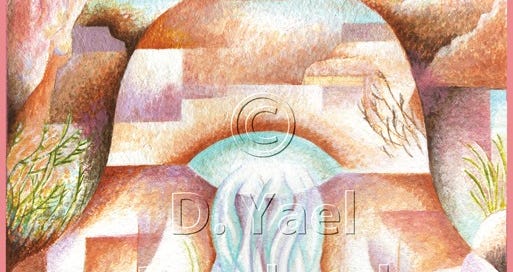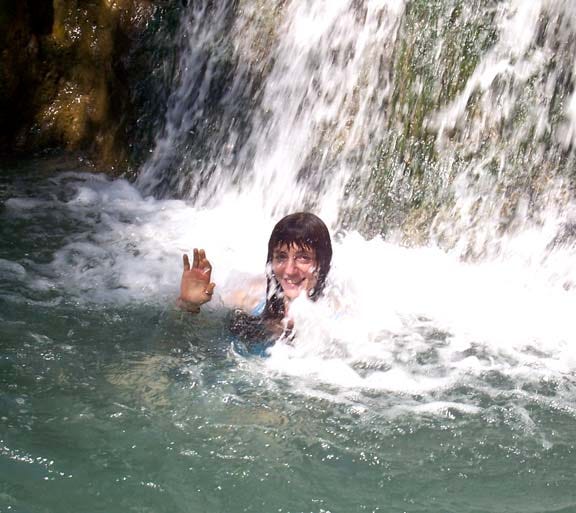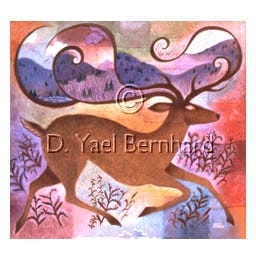Ein Gedi
Ein Gedi, acrylic on handmade watercolor paper, © 2016 D. Yael Bernhard
Ein Gedi is the name of a nature preserve in Israel, south of Jerusalem in the Judean Desert. It features spectacular waterfalls that pour straight from the walls of the desert ravine. The Judean Desert is utterly dry – yet like a miracle from the hand of God, out of the canyon of solid rock comes a waterfall that cascades down toward the Dead Sea. Here it’s said King David took refuge and wrote some of the Biblical Psalms. It’s easy to see the place as a source of inspiration for our ancestors as much as it is today.
The painting’s title is a pun: Ein (עין) in Hebrew means “fountain”, “spring”, or “source”; and also “eye of.” To depict this double meaning, the waterfall issues from a hamsa – a hand-shaped symbol with an eye in the center of the palm, popular in the Middle East as a token of God’s protection. In Israel it comes in endless forms: talismans, jewelry, stained glass, textiles, ceramics, and more. I’ve even seen price tags cut from cardboard in the shape of a hamsa.
I first visited Ein Gedi in 2009, and immediately fell in love with the place. The stark landscape contrasts with the lush waterfalls and green bullrushes that surround them. The human history of the region is unimaginably ancient, dating back thousands of years. The air is hot and dense – below sea level – and the Dead Sea, beautiful and foreboding, rests in the distance. One feels purified in such an environment, as if nature has reduced everything to its essence. In the shimmering heat, I could almost see Abraham with his train of camels, sheep, and donkeys, called to go forth from his birthplace to the land of Cana’an.
In this painting, the land is embedded in the five-fingered hamsa (literally “five” in Arabic). The eye in the palm is divine consciousness, embodied in a human hand – our instrument of creativity. Our hands are what sets us apart from other animals – not just the opposing thumb, but how we use our hands, and for what. Curiously, the hamsa is often depicted with two thumbs, making it symmetrical, such as here.
I can imagine other ways of painting this eye, this hand, this interconnection of nature, human, and divine. This wasn’t the first hamsa I’ve painted, and it won’t be the last.
I loved swimming in those waterfalls – and I hoped, in painting Ein Gedi, I succeeded in conveying some sense of what it felt like to be there – a mingling of natural, historical, and spiritual wonder. That’s Israel.
A good week to all –
D. Yael Bernhard
https://dyaelbernhard.com
Have you seen my other Substack, The Art of Health? In addition to being a visual artist, I’m also a certified integrative health & nutrition coach with a lifelong passion for natural food cooking and herbal medicine. Now in its second year, this illustrated newsletter explores cutting-edge concepts of nutrition. I strive to make relevant information clear and accessible, and to anchor essential health concepts in unique images. Check it out, and if you like it, please subscribe and help spread the word. Your support keeps my work going!







